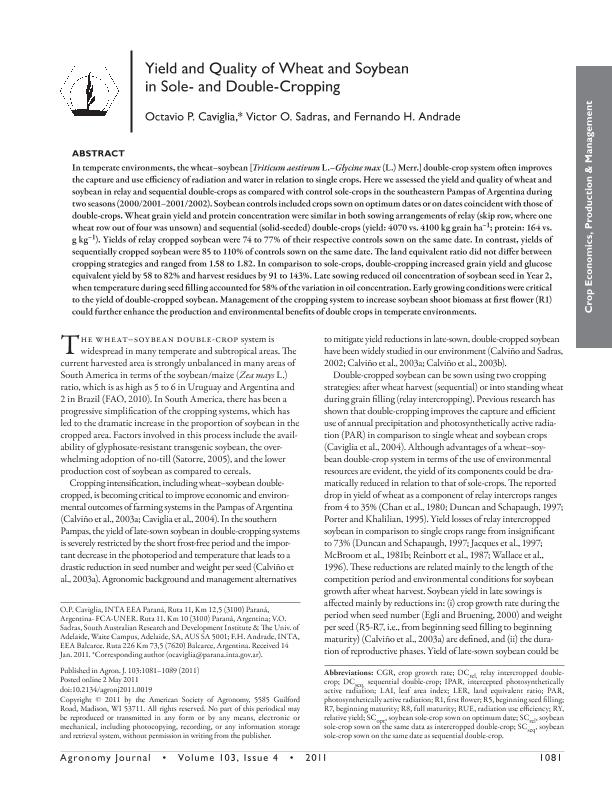Mostrar el registro sencillo del ítem
dc.contributor.author
Caviglia, Octavio Pedro

dc.contributor.author
Sadras, Victor O.
dc.contributor.author
Andrade, Fernando Héctor

dc.date.available
2023-04-05T11:13:47Z
dc.date.issued
2011-05
dc.identifier.citation
Caviglia, Octavio Pedro; Sadras, Victor O.; Andrade, Fernando Héctor; Yield and Quality of Wheat and Soybean in Sole- and Double-Cropping; American Society of Agronomy; Agronomy Journal; 103; 4; 5-2011; 1081-1089
dc.identifier.issn
0002-1962
dc.identifier.uri
http://hdl.handle.net/11336/192773
dc.description.abstract
In temperate environments, the wheat-soybean [Triticum aestivum L.- Glycine max (L.) Merr.] double-crop system oft en improves the capture and use efficiency of radiation and water in relation to single crops. Here we assessed the yield and quality of wheat and soybean in relay and sequential double-crops as compared with control sole-crops in the southeastern Pampas of Argentina during two seasons (2000/2001-2001/2002). Soybean controls included crops sown on optimum dates or on dates coincident with those of double-crops. Wheat grain yield and protein concentration were similar in both sowing arrangements of relay (skip row, where one wheat row out of four was unsown) and sequential (solid-seeded) double-crops (yield: 4070 vs. 4100 kg grain ha-1; protein: 164 vs. g kg -1). Yields of relay cropped soybean were 74 to 77% of their respective controls sown on the same date. In contrast, yields of sequentially cropped soybean were 85 to 110% of controls sown on the same date. The land equivalent ratio did not differ between cropping strategies and ranged from 1.58 to 1.82. In comparison to sole-crops, double-cropping increased grain yield and glucose equivalent yield by 58 to 82% and harvest residues by 91 to 143%. Late sowing reduced oil concentration of soybean seed in Year 2, when temperature during seed filling accounted for 58% of the variation in oil concentration. Early growing conditions were critical to the yield of double-cropped soybean. Management of the cropping system to increase soybean shoot biomass at first flower (R1) could further enhance the production and environmental benefits of double crops in temperate environments.
dc.format
application/pdf
dc.language.iso
eng
dc.publisher
American Society of Agronomy

dc.rights
info:eu-repo/semantics/openAccess
dc.rights.uri
https://creativecommons.org/licenses/by-nc-sa/2.5/ar/
dc.subject
DOUBLE CROPPING
dc.subject
SOYBEAN
dc.subject
MAIZE
dc.subject.classification
Agricultura

dc.subject.classification
Agricultura, Silvicultura y Pesca

dc.subject.classification
CIENCIAS AGRÍCOLAS

dc.title
Yield and Quality of Wheat and Soybean in Sole- and Double-Cropping
dc.type
info:eu-repo/semantics/article
dc.type
info:ar-repo/semantics/artículo
dc.type
info:eu-repo/semantics/publishedVersion
dc.date.updated
2023-04-04T12:07:51Z
dc.journal.volume
103
dc.journal.number
4
dc.journal.pagination
1081-1089
dc.journal.pais
Estados Unidos

dc.description.fil
Fil: Caviglia, Octavio Pedro. Consejo Nacional de Investigaciones Científicas y Técnicas; Argentina. Instituto Nacional de Tecnologia Agropecuaria. Centro Regional Entre Rios. Estacion Experimental Agropecuaria Parana. Agencia de Extension Rural Parana.; Argentina
dc.description.fil
Fil: Sadras, Victor O.. University of Adelaide; Australia
dc.description.fil
Fil: Andrade, Fernando Héctor. Instituto Nacional de Tecnología Agropecuaria. Centro Regional Buenos Aires Sur. Estación Experimental Agropecuaria Balcarce; Argentina. Consejo Nacional de Investigaciones Científicas y Técnicas; Argentina
dc.journal.title
Agronomy Journal

dc.relation.alternativeid
info:eu-repo/semantics/altIdentifier/url/https://acsess.onlinelibrary.wiley.com/doi/abs/10.2134/agronj2011.0019
dc.relation.alternativeid
info:eu-repo/semantics/altIdentifier/doi/http://dx.doi.org/10.2134/agronj2011.0019
Archivos asociados
